This month marks 130 years since one of the most important events in the economic development of Newcastle, when an act of parliament released a large tract of land from a longstanding legal limbo. The Newcastle Pasturage Reserve, also known as the Commonage, consisted of 1600 acres stretching from Waratah to Adamstown. Summarising its history in 1889, the Sydney Morning Herald noted that
“The Newcastle Pasturage Reserve was marked out in 1850 for the purpose of affording a run for stock which were then being shipped to New Zealand. The immediate purpose of it passed away, but the reserve remained. On it were valuable coal seams, and after the passing of the Land Act of 1861 the land inside its boundaries was mostly leased for mining purposes. The opening of the mines drew a large number of miners to the district, many of them without much money, and they began to put up rough shelter for themselves on the reserve, close to their work. There was nobody to forbid them, or to levy any rent. The quality of the houses put up was very inferior, because as they knew they had no title the men naturally did not care to spend too much.”
In 1871 the 300 residents of the Commonage lobbied the government to obtain legal title. For the next eighteen years, governments alternately promised and procrastinated, until finally in June 1889 the Newcastle Pasturage Reserve Act was passed. This gave the residents (now numbering 5000) the right to purchase the land they lived on, and allowed the remaining land to be sold or reserved for public use. Sittings of the Land Court in 1890 set purchase prices, and although residents grumbled they were too high, most took the opportunity to become landowners instead of squatters.
The legal certainty of land title granted by the Act was an essential step that enabled the development of housing, commerce, industry and recreational facilities in the heart of Newcastle, worth billions of dollars today.
The article above was first published in the June 2019 edition of The Local.
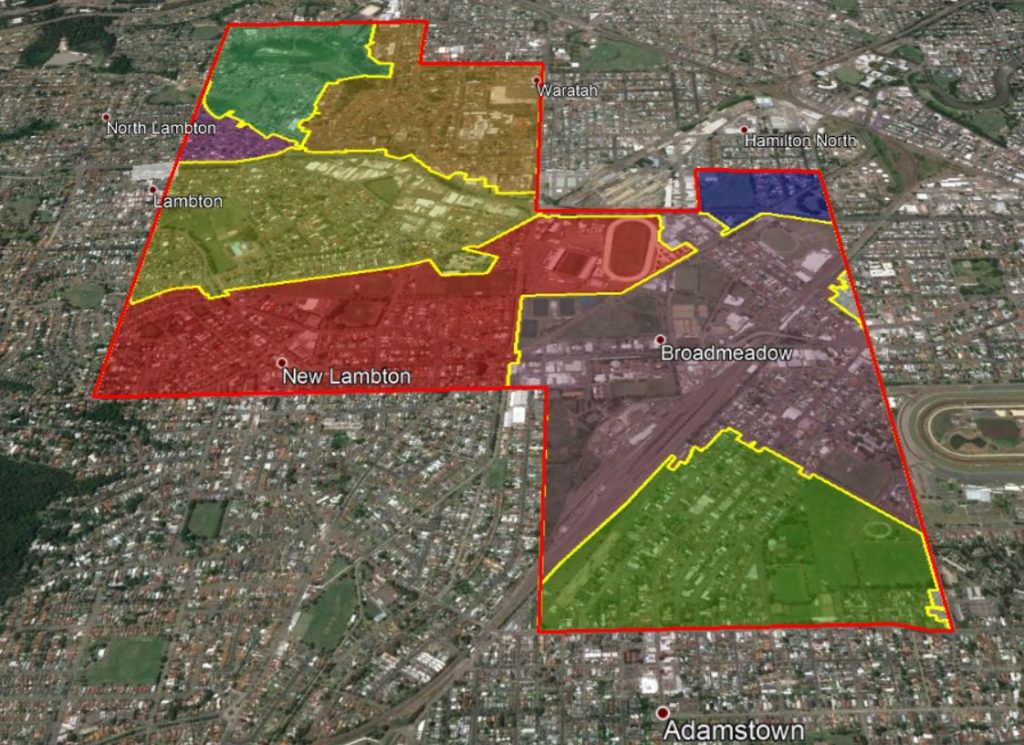
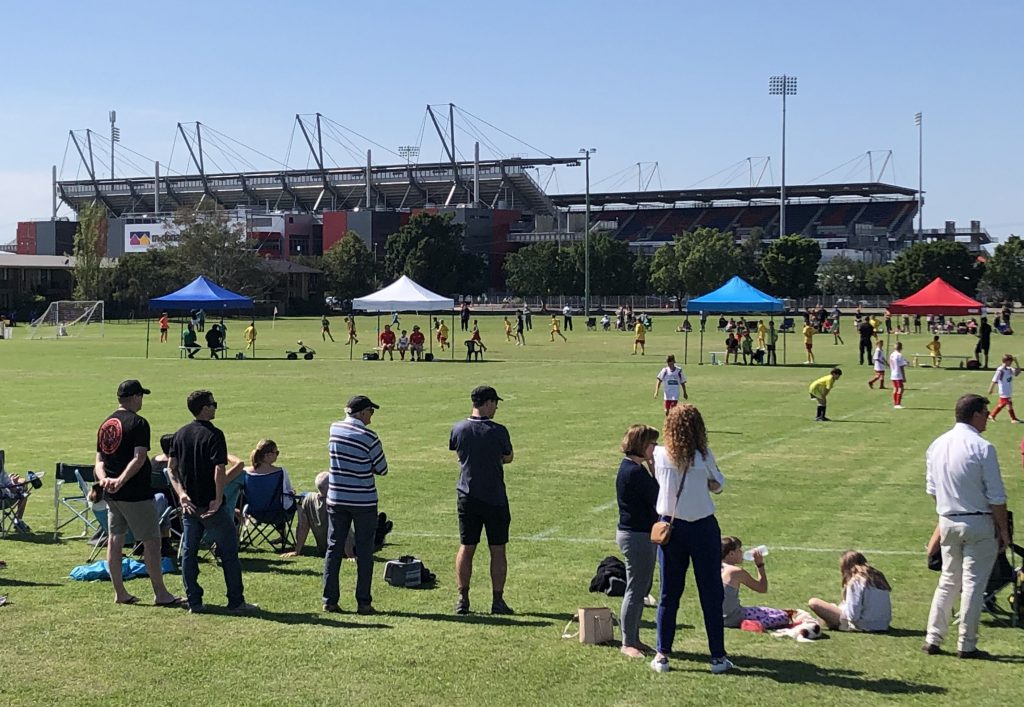
Additional information
In the published article I quoted a small section of a Sydney Morning Herald article from 10 June 1889 which contained a good summary of the history of the Commonage. Here’s the article in full.
The Newcastle Pasturage Reserve was marked out in 1850 for the purpose of affording a run for stock which were then being shipped to New Zealand. The immediate purpose of it passed away, but the reserve remained. On it and cIose around it were valuable coal seams, and after the passing of the Land Act of 1861 the land inside its boundaries was mostly leased for mining purpose, and the land adjoining was conditionally purchased, The opening of the mines draw a large number of miners to the district, many of them without much money to start afresh in the world, and they began to put up rough shelter for themselves on the reserve, as a cheaper arrangement than going into lodgings, or buying an allotment and building. And, indeed, there seems to have been no superabundant supply of township land convenient for their purpose, even if they had been able to buy and build. The common was the most convenient spot for their purpose, and was close to their work. There was nobody to forbid them, or to levy any rent, and one trespass encouraged another. At the same time, the quality of the houses put up was very inferior, because as they knew they had no title the men naturally did not care to spend too much. The houses and rooms are stated to be very small, and many of them overcrowded, but the tenements seem to have been on separate allotments, and being thus detached have fortunately good ventilation.
When the trespassers had come to number three hundred, they felt themselves strong enough to approach the Minister and ask for a favourable consideration of their position. This was as far back as 1871, and Mr. John Bowie Wilson, who was then in charge of the Department, is said to have given the deputation a favourable answer. There is, however, no official record of the promise, and nothing was done. This was the beginning of a long series of deputations, and a series of promises, all of which were destined to be broken, for during eighteen years Minister after Minister has intended to deal with the matter, but has had to leave office before being able to do so. The bill that is now before Parliament is the first that has actually been prepared, the other departmental action having been only to survey the ground. These surveys, however, have been valuable preparatory work, because it appears from them that, with the exception of a few cases in which houses will have to be shifted off the main roads, it will be possible to give every existing occupier about a quarter of an acre, and the balance of the land may be reserved or sold as may be most expedient.
The promises of successive Ministers since Mr. J. B. Wilson first gave encouragement to the trespassers in 1871 seem to have acted like a charm. Every time a deputation went up to the Minister and came back again with an assurance that a bill would be introduced to give some sort of a title, the process of occupation proceeded merrily ; so that while in Mr. Wilson’s time there were only three hundred trespassers to be dealt with, there are now more than a thousand, while the whole population, including women and children, is nearly five thousand. If Mr. Wilson, when giving the first promise, had at the same time sent up a bailiff to see that there was no more trespassing, and had begun to levy a fair rental on the then occupiers of the said ground, the mischief would have been arrested at its then magnitude ; but the first Minister to do anything more than promise was Mr. GARRETT. He issued three writs of intrusion for the sake of asserting the Crown title, and he appointed a bailiff, and so for the last two or three years there has been no increase in the number of trespassers. The Select Committee having to deal with things, not as they ought to have been, but with things as they are, has considered the best course to pursue. At different times there have been different proposals. One Minister thought of giving trespassers annual leases; another proposed to sell the land by auction, securing to the occupier the value of his improvements ; and another to sell the land at an estimated value, and this last is Mr. Brunker’s plan. The committee report that they have considered all three schemes, and have finally decided to support that proposed in the bill. The eviction of so large a number of people is out of the question, especially in the light of so many Ministerial promises that they should be secured in their holdings. To lease the land would not give an adequate stimulus to improvement in the style of tenement, and that seems to have been very much wanted ; and at the whole of the common is not wanted for a reserve, there is no objection to selling, provided the Crown gets a fair price. The conclusion arrived at, therefore, seems to be the best under the circumstances. The trespassers, of course, have not a scrap of legal title ; and, as some of them have been there for more than twenty years without paying any rent, they have had the full value of their improvements. Still, there they are, and they have been encouraged to go there by the neglect of the Government, and to stay there by the promises of the Government, and under the circumstances a compromise must be arrived at. The value of the land will have to be determined by the local land board, but the evidence goes to show that the land is now worth from a hundred to five hundred pounds an acre, so that the Crown will, at any rate, get a revenue from the sale, and will, in fact, get more than if the land had been sold prior to its occupation. The people, by settling on the land and making a township of it, have given a value to the land which it did not previously possess. After all the claimants have been satisfied, there will still be a good deal available for auction, and an adequate amount left for public reserves.
Because there was some doubt as to whether the commonage area had been formally gazetted back in 1850 when it was first set aside by the government, the area was formally reproclaimed in the Crown Lands Alienation Act, published in the Government Gazette of 24 December 1861.
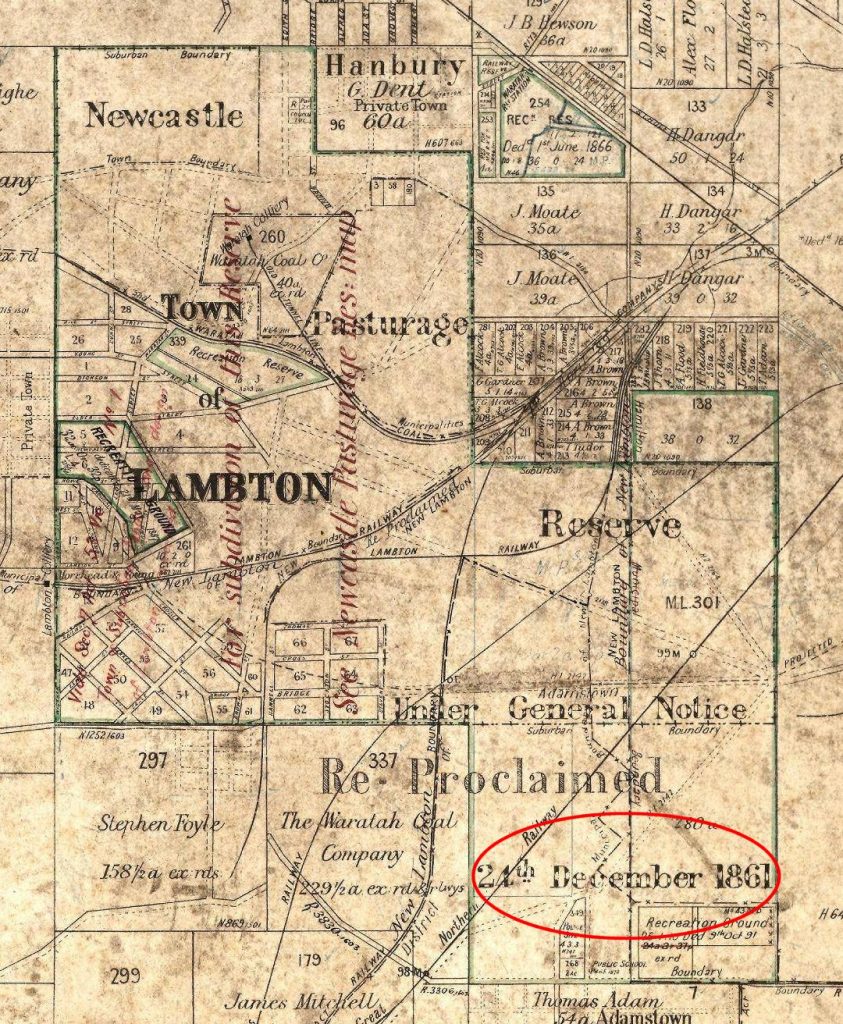
Some 60 years after the creation of the Pasturage Reserve, a short Newcastle Morning Herald article on 16 November 1910 indicated that the genesis of the reserve was in 1849.
The large area of ground known as the Pasturage Reserve, stretching from a point to the south-east of New Lambton well up into the Waratah municipality, was set apart about 60 years ago, for the purpose of enabling the residents of Newcastle to depasture cows thereon. The first reference to the matter of making the reserve is contained in a letter from Horace Charlton, local surveyor, to the bench of magistrates, at Newcastle, on 21st December 1849: – “Gentlemen – Having received instructions from the Surveyor-General, by his letter dated February 8th, 1849, No. 49/61, to consult the magistrates and other well-informed inhabitants of Newcastle as to the propriety of making a reserve for depasturing the townspeople’s milch cows, I forward herewith a map of all the lands in the vicinity of that city, and shall feel obliged by receiving your opinion as to which of the lands still vacant beyond Throsby’s Creek will be most suitable for such a purpose.
The Land Court
In July to September of 1890 the government held 41 days of sittings of the Land Court, to adjudicate on applications from Commonage residents to purchase their allotments. The court either allowed or disallowed applicants to purchase based on the nature of the improvements they had made on the land. Occasionally there were multiple applicants for the same portion of land, and the court had to decide which (if any) applicant would be successful. For successful applicants, the court then set a purchase price, based on evidence provided by valuers, and occasionally calling witnesses to testify.
The outcome of the land court sittings were published in the newspaper each day. They provide an interesting snapshot of the residents of the Commonage in 1890, with incidental details of the nature of various businesses and enterprises conducted in the area at the time. I have compiled a list of all the names of people who were applicants in the land court hearings. The list is available in Excel Online or as a PDF.
The Historical Land Records Viewer has a two part map that shows the Newcastle Pasturage Reserve with the lot numbers as mentioned in the land court hearings. An excerpt of the map is shown below.
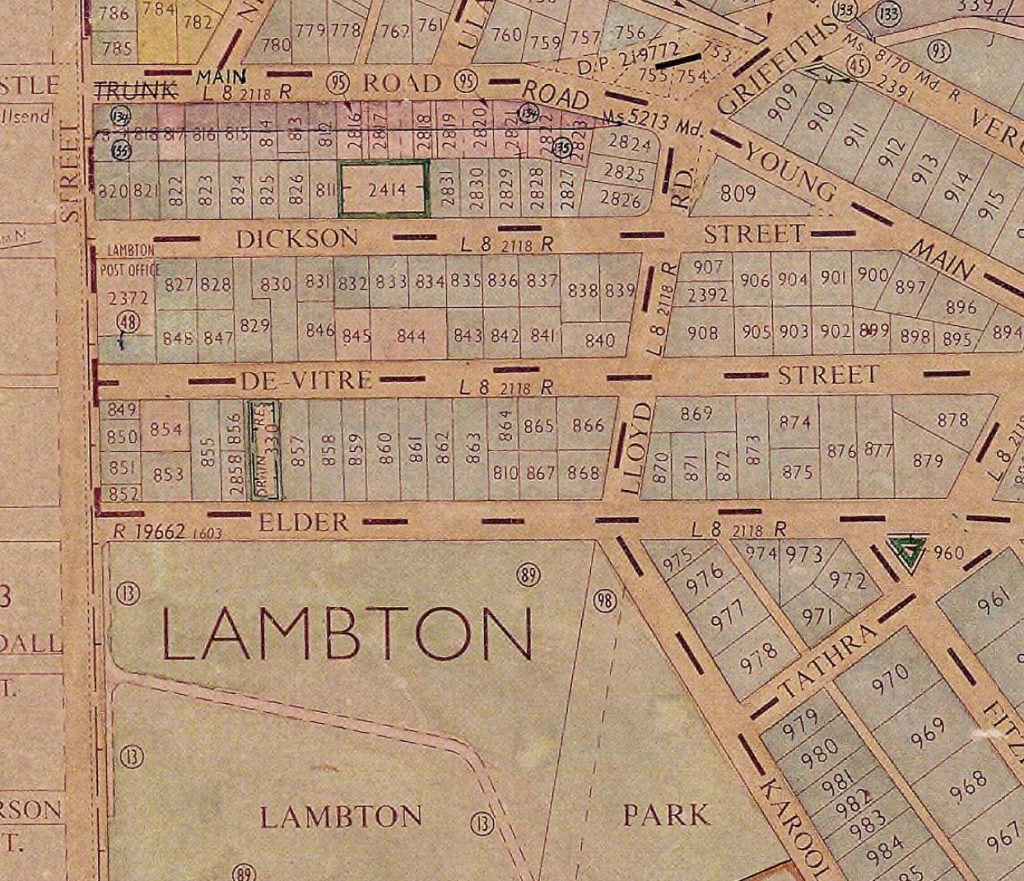
Note that this map is a seventh edition dated 18 August 1976, with later additions up to January 1978. Although this is nearly 90 years after the Commonage allotments were mapped out, I have provided a link to this map rather than an older one because the lot numbers are the same as in 1890 and are easier to read in this ‘modern’ rendering of the Newcastle Pasturage Reserve map.
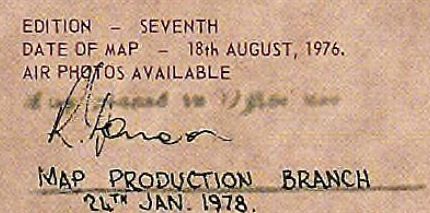
Click on the images below to view the full map details.
| Day | Date Occurred | Date reported |
| 1 | 7/7/1890 | 8/7/1890 |
| 2 | 8/7/1890 | 9/7/1890 |
| 3 | 9/7/1890 | 10/7/1890 |
| 4 | 11/7/1890 | 12/7/1890 |
| 5 | 18/7/1890 | 19/7/1890 |
| 6 | 19/7/1890 | 21/7/1890 |
| 7 | 21/7/1890 | 22/7/1890 |
| 8 | 22/7/1890 | 23/7/1890 |
| 9 | 23/7/1890 | 24/7/1890 |
| 10 | 24/7/1890 | 25/7/1890 |
| 11 | 28/7/1890 | 29/7/1890 |
| 12 | 29/7/1890 | 30/7/1890 |
| 13 | 30/7/1890 | 31/7/1890 |
| 14 | 31/7/1890 | 1/8/1890 |
| 15 | 4/8/1890 | 5/8/1890 |
| 16 | 5/8/1890 | 6/8/1890 |
| 17 | 6/8/1890 | 7/8/1890 |
| 18 | 7/8/1890 | 8/8/1890 |
| 19 | 8/8/1890 | 9/8/1890 |
| 20 | 11/8/1890 | 12/8/1890 |
| 21 | 12/8/1890 | 13/8/1890 |
| 22 | 13/8/1890 | 14/8/1890 |
| 23 | 14/8/1890 | 15/8/1890 |
| 24 | 15/8/1890 | 16/8/1890 |
| 25 | 18/8/1890 | 19/8/1890 |
| 26 | 19/8/1890 | 20/8/1890 |
| 27 | 20/8/1890 | 21/8/1890 |
| 28 | 21/8/1890 | 22/8/1890 |
| 29 | 22/8/1890 | 23/8/1890 |
| 30 | 25/8/1890 | 26/8/1890 |
| 31 | 26/8/1890 | 27/8/1890 |
| 32 | 27/8/1890 | 28/8/1890 |
| 33 | 28/8/1890 | 29/8/1890 |
| 34 | 29/8/1890 | 30/8/1890 |
| 35 | 1/9/1890 | 3/9/1890 |
| 36 | 2/9/1890 | Day 36/37 reported together |
| 37 | 3/9/1890 | 5/9/1890 |
| 38 | 4/9/1890 | Day 38/39 reported together |
| 39 | 5/9/1890 | 6/9/1890 |
| 40 | 8/9/1890 | 9/9/1890 |
| 41 | 9/9/1890 | 10/10/1890 |
Post 1890
Most people residing on the commonage prior to the passing of the Pasturage Reserve Act in 1889 took up the option of purchasing. Although the expectation was that this was a good investment and that land values would increase, depressed economic times meant that many people had trouble paying for their land in the time allotted. A report in September 1895 described the problem.
The occupiers were allowed to purchase their holdings by auction, the price being made payable by instalments. Since that time another short Act has been passed for the purpose of facilitating the purchases and promoting the objects of the original Act. But since the passing of the second Act a very serious change has come over the coal-mining industry in this quarter. Wages have gone down, work has become lamentably slack, the outside municipalities are generally staggering under burdens of debt, and serious shrinkages of values have taken place almost everywhere. Many of the people have had within the last two years hard work to keep soul and body together, without at all thinking as to how the instalments on their holdings are to be paid to the Government.
The Government in 1895 thus passed an amendment to the Pasturage Reserve Act to provide purchasers with more lenient repayment terms. As the newspaper report noted …
People are now beginning to discover that large tracts of land are next to useless without inhabitants, and that it is good policy to make the conditions of settlement so easy that the poorest person, if desirous of earning an honest livelihood, can fulfil them.
Land values remained depressed in the Commonage area for many years. Charles Baker of Waratah, writing to the newspaper in June 1906 complained that …
The land was never at any time worth the Government prices put upon. it. The effect of that mistake was that almost every resident became victims to departmental overvaluation. To-day probably 700 to 800 of these original residents have become dispossessed of their holdings from various causes, but chiefly owing to the price charged being beyond their means.
A newspaper report the following month in July 1906 stated that …
As regards land values, they have certainly depreciated from 15 to 25 per cent during the last ten years. This is due to three causes – depression in the mining industry, the cessation of Lambton, Waratah, Burwood, and other large collieries, which are worked out, and no longer give employment, and the opening and development of the Maitland coalfields, which have attracted large number of miners and business people from these suburbs.
Despite this temporary setback, the land eventually appreciated in value. In April 1921 it was reported that …
The unsold allotments in the Newcastle pasturage reserve, which a few years ago was regarded as little value, are being taken up, and in some instances the purchase has exceeded the upset [reserve] prices. Inquiries are being made almost daily from applicants desirous of purchasing land in the locality.
Current Value of the Commonage Area
In the published article I stated that the passing of the Newcastle Pasturage Reserve Act in 1889 “enabled the development of housing, commerce, industry and recreational facilities in the heart of Newcastle, worth billions of dollars today.”
I have no qualifications in geo-econometric modelling, so exactly how many billions of dollars the Commonage area is now worth, is difficult to say. However one piece of hard data that can help answer this question is the land value of residential property. The Valuer General of NSW has made available land values via the NSW Globe KML from Spatial Services.
Looking at a small section of residential housing in the middle of the Commonage area adjacent to Turton Rd New Lambton, there are 88 properties over 11 acres valued at a total of 39.5 million dollars. This averages out to 3.6 million dollars per acre.

The Commonage covered approximately 1600 acres, and about half that area is now used for residential purposes. In residential areas, the streets comprise about 15%, so the area of land of the actual residences will be about 680 acres. Therefore the total land value of residences will be approximately 680 x 3.6 million, which is 2.4 billion dollars.

Note that this estimate of 2.4 billion dollars is just the land value of residences, and doesn’t include the value of buildings, or of industrial land and facilities, public reserves, streets or other infrastructure. Including all these probably puts the value of the Commonage area today into the tens of billions of dollars.
Newspaper articles
| Article Date Event Date | Notes |
|---|---|
| 4 Nov 1857 | Brief mention of the Commonage Reserve in connection with discussions on the proposed Newcastle Municipality. |
| 25 Oct 1860 | “Mr. ROBERTSON said that no portion of the surface land referred to had been leased to any one, but permission had been given some years ago to Messrs. Morehead and Young to work the coal on the land before the reserve was made, and that permission had afterwards been transferred to the A. A. Co. It was clear that the Municipal Council of Newcastle could have no claim to the coal. The land was given to them for grazing purposes, and was still at their disposal for commonage." |
| 24 Dec 1861 | Proclamation in the Government Gazette of "The Crown Lands Alienation Act, 1961". As there was uncertainty about whether the Newcastle Commonage had been formally proclaimed back in 1850, this Act reproclaimed the commonage area as being excluded from conditional sale. |
| 1 Jun 1865 | Public meeting on the issue of reserves, at which it is bemoaned that Newcastle Council had not been granted title to the surface of the commonage area, whilst under the surface the state government had leased out the mining rights to coal companies at a measly rate of £2 per acre. |
| 2 Sep 1871 | Public meeting of the Commonage residents, held at Griffiths Flat. |
| 21 Sep 1871 20 Sep 1871 | Public meeting of the Commonage residents, held at Griffiths Flat, reporting on the deputation sent to the Minister for Lands. |
| 20 Nov 1873 | The name 'Newcastle Pasturage Reserve' first appears in the newspapers, in an article about the nuisance of goats roaming the streets … "We see no reason why these useful animals should be denied the right of pasturage on the public reserves. The 2000 acres usually designated Newcastle Pasturage Reserve, was intended by the Government for this very purpose." |
| 29 Sep 1874 | “Urged by deputation after deputation, the Government consented to survey and value the Commonage, and put it up for sale by auction. Accordingly Surveyor Evans surveyed the Common into allotments, and made a valuation thereof. The persons resident thereon were much elated by this proceeding, and thought that they would be able to purchase the land on which they dwelt, but their joy was not of long duration, as since the survey and valuation nothing towards a final disposal of the allotments has been done.” |
| 22 Sep 1875 | “The influx of strangers into this part of the district is creating a great demand for houses, which are not to be obtained at any price. Several very substantial houses are at present being built on the Commonage. It is fortunate for poor people that they have the Commonage to build upon, as the high price of land in the township takes it completely out of their reach.” |
| 26 Mar 1885 | Waratah Council meeting discusses the Commage … “Alderman CHAPMAN said the Mayor was in error with reference to the trustees been appointed for the Commonage. It was only proclaimed in a Government Gazette as the Newcastle Pasturage Reserve. The MAYOR said he had been informed by a very good authority on the history of Newcastle. Alderman TURTON said that the late Mr. James Hannell, when member for Newcastle, was asked to nominate trustees. He did so, but they were never officially appointed.” |
| 1 Aug 1885 | "Last Saturday the Minister for Lands visited Newcastle with the view of making himself acquainted with the circumstances attending the settlement of a large number of people on the Newcastle Pasturage Reserve, better known as the Common. This reserve is situated about four miles distant from the city, in the vicinity of Adamstown Hamilton, Waratah, and Old and New Lambton. It comprises an area of 2000 acres, and is settled on by 800 families, representing an estimated population of 4000 souls." |
| 15 Dec 1888 | Mr Brunker introduces a bill to the Legislative Assembly to deal with the Commonage question. "Petitions were forwarded and deputations waited upon Ministers year after year, but with little success ... One Minister after another shrunk from solving this problem, and it appears to have remained for Mr. BRUNKER to make a final effort to do so." |
| 23 Apr 1889 | "It is about time that the residents on the Commonage began to take an earnest and intelligent interest in the question of the legalisation of their unauthorised occupation of portions of the public estate." |
| 24 Apr 1889 | A meeting of the Commonage residents held in Lambton Park, where "it was decided to appoint Mr. Melville to represent the interests of the commoners before the select committee of the Legislative Council." |
| 27 Apr 1889 | A history of the Commonage as presented by the residents of the common in the lead up to the passing of the Newcastle Pasturage Reserve Bill later that year. |
| 10 Jun 1889 | A report on the Newcastle Pasturage Reserve Bill contains a good summary of the history of the commonage. |
| 22 Jun 1889 21 Jun 1889 | "PARLIAMENT. FRIDAY, JUNE 21, 1889. LEGISLATIVE ASSEMBLY. The Speaker announced the assent of the Governor to the Newcastle Pasturage Reserve Bill." |
| 24 Jun 1889 22 Jun 1889 | Meeting of the Commonage residents near the New Lambton bridge. "Mr. MELVILLE said he had felt that, seeing the Commonage bill had been passed, it was now his duty to come up and explain the position of the residents." |
| 18 Jul 1889 | “The history of the Commonage, as told by Mr. GEORGE LEWIS to the Select Committee on the bill, shows that prior to 1861 the land was shown on the maps as a reserve for the purpose of depasturing cattle prior to their shipment for New Zealand and elsewhere. The boundaries were clearly defined and charted, and have never been questioned. It is yet a moot point whether the land was formally dedicated by the Government as a reserve.” |
| 3 Nov 1894 | "The Minister for Lands was urged, the other day, by a deputation to have a reappraisement of the holdings on the Newcastle Pasturage Reserve, or to grant a reduction or rebate of 25 per cent, of the appraised value, or to waive the claim for for interest on the deferred payments." |
| 28 Feb 1895 | "A MEETING of Commonage residents was held at the Premier Hotel, Broadmeadow, on Friday evening, to receive the report of the deputation which waited on the Minister for Lands, asking for a proportionate reduction in the appraised values of their respective holdings." |
| 21 Sep 1895 | A bill introduced to Parliament to amend the Pasturage Reserve Act to provide more lenient repayment terms. |
| 10 Jul 1906 | "from recent estimates by the police and local council clerks, the settled population on the pasturage reserve is between 7000 and 8000 ... the total area of the reserve is about 1600 acres; it was subdivided into about 2500 portions of which number only 585 remain vacant... As regards land values, they have certainly depreciated from 15 to 25 per cent during the last ten years." |
| 16 Nov 1910 | "The first reference to the matter of making the reserve is contained in a letter from Horace Charlton, local surveyor, to the bench of magistrates, at Newcastle, on 21st December 1849." |
| 18 Apr 1921 | "The unsold allotments in the Newcastle pasturage reserve, which a few years ago was regarded as little value, are being taken up, and in some instances the purchase has exceeded the upset [reserve] prices. Inquiries are being made almost daily from applicants desirous of purchasing land in the locality" |

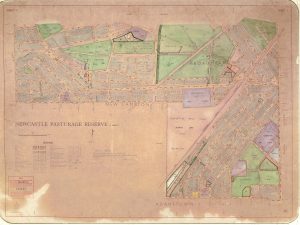
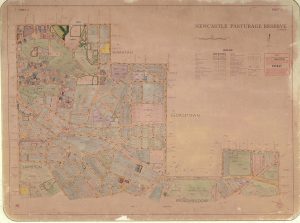
Hello Lachlan,
The Pasturage Reserve maps 1 & 2 are very interesting. They look old, but I see modern street names and dates of 1968 & 1972. Do you know when these maps were created ? Or have they been updated over time ?
Regards,
Anthony Finnegan
Thanks for your observation. I’ve updated the body of the article with some more information on the map, which is dated 18 August 1978.